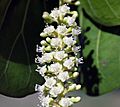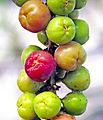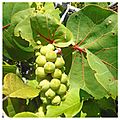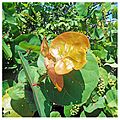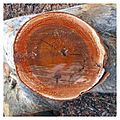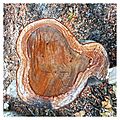Seagrape facts for kids
Quick facts for kids Seagrape |
|
|---|---|
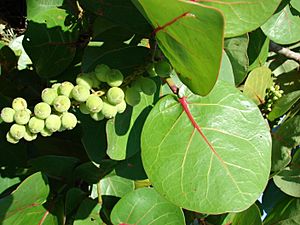 |
|
| Conservation status | |
| Scientific classification | |
| Genus: |
Coccoloba
|
| Species: |
uvifera
|
The Coccoloba uvifera, also known as seagrape or baygrape, is a type of flowering plant. It belongs to the buckwheat family. This plant grows naturally on coastal beaches in tropical America and the Caribbean. You can find it in southern Florida, the Bahamas, the Greater and Lesser Antilles, and Bermuda.
Contents
Seagrape Fruit
In late summer, the seagrape plant grows green fruit. These fruits are about 2 cm (0.8 in) wide. They grow in large bunches that look like grapes. As the fruit ripens, it slowly changes to a purplish color. Each fruit has a big seed inside, which takes up most of the space.
Growing Seagrape Plants
Seagrape trees can live in temperatures as low as about 2 °C (35.6 °F). However, they cannot survive if there is frost. Before their leaves die, they turn reddish. The seeds of the seagrape must be planted right away. Unlike many other plants, seagrape seeds cannot be stored for planting later.
This plant is very strong against wind. It can also handle some shade. It is very good at living in salty conditions. Because of this, people often plant seagrape trees to help keep beach edges stable. They are also planted as pretty shrubs. The fruit tastes very good. You can eat it fresh from the tree or use it to make jam.
How Seagrape Plants Reproduce
Seagrape is a dioecious species. This means that male flowers and female flowers grow on different plants. For the plant to make fruit, pollen from a male plant must reach a female plant. Honey bees and other insects help move the pollen. You can tell male and female plants apart by their flowers. Male plants often have old flower stalks that are no longer alive.
- Where it grows best: USDA zone 9B–11
- How to grow it: From seeds or by taking cuttings (pieces of the plant).
- Growing conditions: Needs some shade or full sun, and can handle dry weather.
Uses of Seagrape
The Coccoloba uvifera is a popular plant in yards in south Florida. It helps keep sand dunes from moving. It also provides a safe home for small animals. Tall seagrape plants behind beaches are helpful for sea turtles. They block bright lights from nearby buildings. This stops the turtles from getting confused when they hatch and try to find the ocean.
The sap from the seagrape tree has been used to color things and to treat leather. The wood is sometimes used to make furniture. It can also be used as firewood or to make charcoal. The fruits can be eaten raw. They can also be cooked to make jellies and jams. Some people even make seagrape wine.
Seagrape History and Name
In 1696, two people, Hans Sloane and Leonard Plukenet, gave the plant its first scientific names. They both called it something like "sea-grape," because it looked like grapes growing by the sea. People who explored these areas often used this idea of a "sea-grape." The native people, however, thought it looked like a large mulberry.
Later, in 1753, Carl Linnaeus first named the plant Polygonum uvifera. He said he had not seen its flowers. Then, in 1756, Patrick Browne created the name Coccoloba for it. Linnaeus used Browne's idea in 1762 and changed the plant's name to Coccolobus uvifera. The name Coccoloba comes from a Greek word, kokkolobis. This word means a type of grape, or literally, "berry pod."
Gallery
-
Seagrape (Coccoloba uvifera) shrub at Playa Lucia, Yabucoa, Puerto Rico.
See also
 In Spanish: Coccoloba uvifera para niños
In Spanish: Coccoloba uvifera para niños




